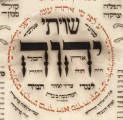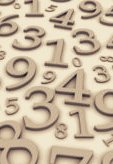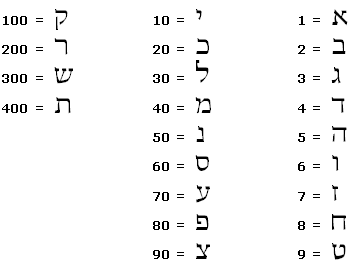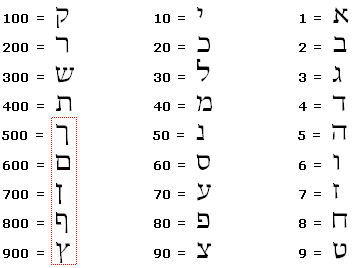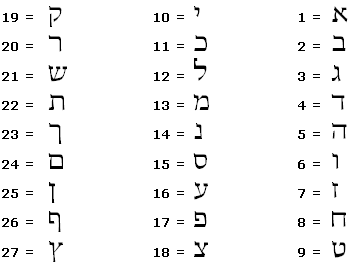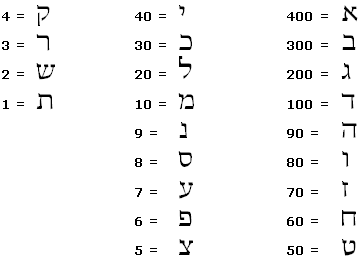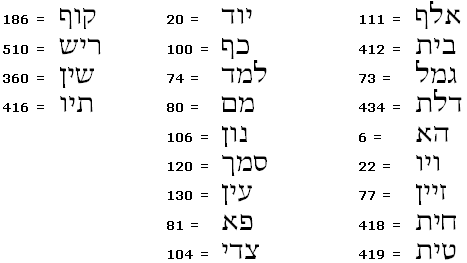|
|
||||||||||||||||||||
|
Within the earliest Jewish traditions, groups of Jewish scholars counted the number of times each letter appeared in the Scriptures (as well as the number of words, verses, paragraphs, etc.). These textual specialists were called Soferim (counters). The Soferim ensured that every Torah scroll (and the other books of the Tanakh) were identical, noting any unusual words and spellings and replicating them exactly through their scribal arts. Many Jews believe that Ezra the Scribe instituted many of the practices of the Soferim. |
|
|
|
According to most practitioners, there are several methods used to calculate the numerical value for individual words and phrases. When converted to a number, words/phrases can then be compared to other words/phrases and similarities drawn. I list the most common Hebrew gematria methods below. |
|
The Standard Method |
|
Each letter of the Hebrew alphabet is given an assigned number, beginning with one for Aleph, two for Bet, and so on. The tenth letter, Yod, is numerically equivalent to 10, and successive letters equal 20, 30, 40, and so on. The letter Qof near the end of the alphabet, equals 100, and the last letter, Tav, equals 400. This method is sometimes called "Ragil." Using this method, you simply add up each letter of a given word (or phrase) to determine its numerical value: |
||||||||
|
Mispar Gadol Method |
||||||||
|
The mispar gadol method is the same as the standard method (above) but counts the final forms (sofit) of the Hebrew letters as a continuation of the numerical sequence for the alphabet. These sofit letters are assigned from 500 to 900, respectively: |
||||||||
|
Mispar Katan Method |
||||||||
|
The mispar katan method calculates the value of each letter as its standard value but simply truncates all of the trailing zeros. Thus the Gematria of Chet is 8, Tet is 9, but Yod is 1 (not 10), Kaf is 2 (not 20), etc., Peh is 8, Tsade is 9, Qof is 1, Resh is 2, and so on: |
||||||||
|
Ordinal Value Method |
||||||||
|
Using this method, each of the 27 Hebrew letters is assigned an ordinal value from one to twenty-two. For example, Aleph (the first letter) equals 1, Bet (the second letter) equals 2, and so on up to the final Tsade (the last letter), which equals 27: |
||||||||
|
At Bash Method |
||||||||
|
Using at Bash, each letter (of a word or phrase) is exchanged with its "opposite" letter and then the result is calculated. "Opposite" letters are determined by substituting the first letter of the Hebrew alphabet (Aleph) with the last letter (Tav), the second letter (Bet) with the next to last (Shin), and so on. The table below shows the values of individual letters: |
||||||||
|
Mispar HaKadmi Method |
||||||||
|
With the mispar hakadmi method, each letter is the sum of the all the standard gematria letter values preceding it. Therefore, the value of Aleph is 1, the value of Bet is 1+2=3, the value of Gimmel is 1+2+3=6, and so on. |
||||||||
|
Mispar HaPerati Method |
||||||||
|
With mispar haperati, the value of each letter is the square of its standard gematria value. Therefore, the value of Aleph is 1*1=1, the value of Bet is 2*2=4, the value of gimmel is 3*3=9, and so on. The table below shows the values of individual letters: |
||||||||
|
Mispar Shemi Method |
||||||||
|
Millui or full-letter filling - The value of each letter is equal to the value of its name (the spelling of the name of the number comes from the Talmud). Therefore, the value of the letter Aleph is (1+30+80) = 111, Bet is (2+10+400) = 412, etc. |
||||||||
|
Gematria Learning Resources: |
||||||||
|
|
